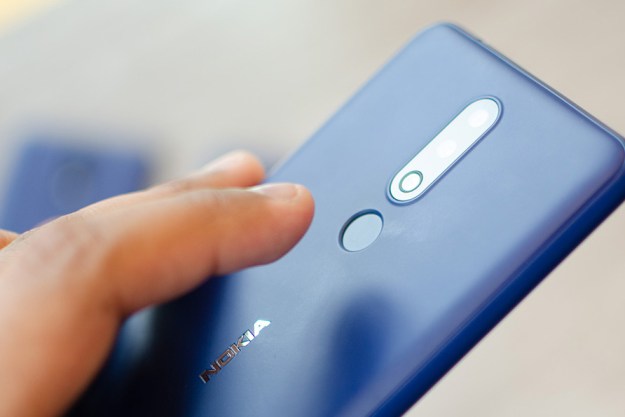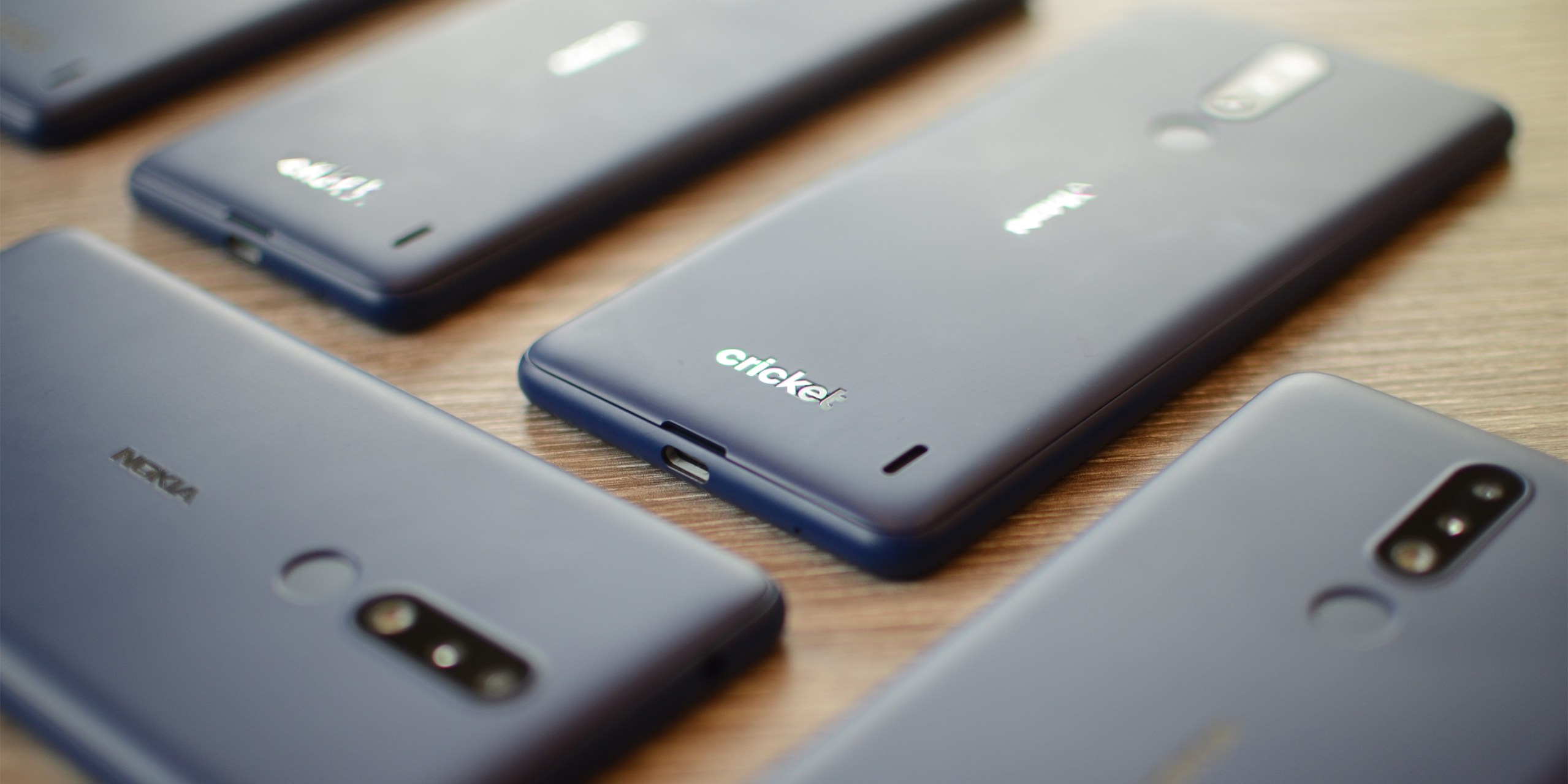
“The Nokia 3.1 Plus is crippled by its camera.”
- Good design, great build quality
- Excellent battery life
- Solid performance
- Affordable
- Mostly untouched Android 9 Pie software
- Only on Cricket Wireless
- Poor camera
- Slow, finicky fingerprint sensor
- Dim display
HMD Global is making a major push into North America this year, and its first smartphone on a U.S. carrier is the Nokia 3.1 Plus on Cricket Wireless. It’s no flashy flagship — costing just $160 — but you wouldn’t be able to tell it cost so little from using it day-to-day. With fantastic battery life and solid performance, it comes close to being great, but the camera holds this budget smartphone back.
Great build quality, dim display
The Nokia 3.1 Plus looks and feels like it deserves a higher price tag. It shares a resemblance to many other Nokia phones we’ve seen from HMD, with a centrally-placed vertical camera setup as well as a fingerprint sensor on the back. The blue-and-matte look makes it stand out from the sea of black phones.
While it looks good, the Nokia 3.1 Plus feels great. Its heft makes it more substantial. The rear is polycarbonate along an aluminum frame, not glass, which means you can worry less about breaking the phone. The phone feels like a brick, and like Nokia phones of old, you could probably toss it across a room without much damage (but don’t try it, please).
The edges are rounded, so the phone can sit comfortably in your hand. It’s large, though, so you might find it tough to reach the top of the screen when holding it with one hand, since it has a tall 18:9 aspect ratio. Those in favor of smaller phones may find it too big.
The matte back tends to pick up smudges, but they’re easy to wipe away. The polycarbonate shell is removable. A small lip at the bottom, by the USB-C charging port, helps pry it off. It’s only for inserting a MicroSD card or SIM card. You can’t replace the battery. The MicroSD card will come in handy, as this phone only comes with 32GB of internal storage, which can fill up quickly. You’ll also be happy to see a headphone jack along the top of the phone.
The Nokia 3.1 Plus looks and feels like it deserves a higher price tag.
Chunky bezels surround the 5.99-inch IPS LCD screen. The top bezel has the earpiece, a Nokia logo, and the selfie camera. The bottom bezel, also known as the “chin,” doesn’t house anything. It doesn’t follow the bezel-less trend for phones, but the Nokia 3.1 Plus doesn’t look too dated. The screen has rounded corners to help it look more modern.
The screen boasts 1,440 x 720 resolution. It’s easy to see individual pixels if you bring the phone close to your eyes, but they’re tough to spot at a normal viewing distance. Colors look a little muted, and viewing angles aren’t great, so it’s tough to identify what’s on the screen when looking at it in an angle. Our biggest gripe is that the display is a bit dim, so we had trouble seeing it clearly in broad daylight.

The best word for the screen is “adequate.” Videos on Netflix and YouTube never look sharp, and colors look washed out. We compared it with the similarly-priced Moto E5 Plus (also on Cricket Wireless) and found the Motorola phone offered better image quality and more realistic colors, which we preferred over the slightly brighter Nokia phone. We wouldn’t want to use the Nokia 3.1 Plus to binge-watch a whole series, but it’s manageable if you must.
Decent performance despite the low price
The Nokia 3.1 Plus has been available in international markets for some time, but the U.S. model is slightly different. It has a Qualcomm Snapdragon 439 processor with 2GB RAM instead of the MediaTek chipset in the global edition. The performance should be comparable, and it’s satisfactory.
Everything happens more slowly than on a flagship phone, which is understandable. Apps take a few moments to load and transitioning to another takes a little longer. The fingerprint sensor is finicky, and you may see some stutters when scrolling through apps like Instagram and Twitter. But remembering the $160 price tag, we were surprised at how many everyday tasks we could complete on the Nokia 3.1 Plus.
- AnTuTu 3DBench: 77,707
- Geekbench 4 CPU: 902 single-core; 3,535 multi-core
- 3DMark Sling Shot Extreme: 495 (Vulkan)
Benchmark scores place this phone higher than other phones in a similar price bracket, like the Moto E5 Plus. That makes sense, as it uses a slightly better processor. In terms of gaming, expect to only play games that don’t require much graphical power. We could hardly get through a game of PUBG: Mobile due to slow frame rates. Games like Breakneck and Alto’s Odyssey were playable, but we had to deal with slight stutters during gameplay. Simpler titles should pose no issue, but this is not ideal for heavy mobile gamers.
Simple titles should pose no issue, but this phone is not ideal for heavy mobile gamers.
This is not the phone to buy if your job heavily relies on your smartphone and you need to perform tasks quickly. The Nokia 3.1 Plus may surprise you with its capability, but it will require just a little patience. We strongly recommend the OnePlus 6T for people looking for strong performance on a budget, though it’s really in a different league of pricing.
Another reasonable option is the Moto G7 Play, which is available in the spring. It’s powered by a Snapdragon 600-series processor, and it only costs $40 more than the Nokia 3.1 Plus.
No Android One software
Most Nokia phones from HMD Global run Google’s Android One software, which means it’s the pure, unaltered version of Android straight from Google. That means the phones receive fast version and security updates straight from Google, and there’s almost zero bloatware. Unfortunately, to sell its phones in U.S. carrier stores, HMD had to drop the Android One branding — neither the Nokia 2V on Verizon or the Nokia 3.1 Plus are a part of the program.

HMD said it plans to work with carrier partners to deliver fast updates to these phones. We can only hold the company to its word. Thankfully, it has a good track record so far — it’s one of the only manufacturers that has delivered Android Pie (the latest version) to many already-released phones. However, you’ll have to deal with bloatware when you first boot up the Nokia 3.1 Plus. Apps like Amazon Shopping, Candy Crush Friends, Candy Crush Saga, Daily Pedometer, Final Fantasy XV: A New Empire, Yahoo! Finance, and more come pre-installed on the phone, eating up valuable storage space. Thankfully, you can uninstall almost all of these and never have to worry about them after setting the phone up.
As another positive, the Nokia’s 3.1 Plus does run Android 9 Pie, and it just may be one the cheapest phones around with it. The software interface is dead simple to use, and best of all it looks good.
HMD says it plans to work with carrier partners to deliver fast updates.
One feature we like about this phone is the inclusion of a near-field communication (NFC) sensor. This is often non-existent on budget phones — see Motorola’s latest Moto G7 range, which costs more than the Nokia 3.1 Plus — but the inclusion here means you can use the Nokia phone for contactless payments via Google Pay, or share files and more through Android’s native Beam technology.
The camera sinks the ship
The Nokia 3.1 has a dual-camera setup on the back. It’s a 13-megapixel lens paired with a second 5-megapixel lens. This combination allows for Live Bokeh photos — known as Portrait Mode on other phones – but that’s the only bonus feature. Optical zoom is MIA, which we didn’t really expect on such a cheap phone.
The specs look fine, but the results sadly fall short. We’ve hardly captured a photo that’s sharp in all our time testing the Nokia 3.1 Plus. Even outdoor photos taken in broad daylight, which budget phones like the Moto E5 Plus and the Nokia 6.1 can handle, look fuzzy. Any kind of movement, whether it’s from the subject or your shaky hands, will produce a blurry photo. The camera has trouble focusing in low-light scenarios, so the photos are often unusable.

The Live Bokeh feature produces surprisingly accurate blurred effects around subjects, but they’re not any sharper. The 8-megapixel camera on the front can take decent selfies, but it’s no better than the competition.
Decent photos occasionally came out of the Nokia 3.1 Plus, but most of the time we opted to avoid using the camera. It’s disappointing, as there’s a lot to like about the phone, and it’s not like there aren’t better cameras in this price range. The Moto E5 Plus can take better photos, and it costs around the same (depending on where you buy it from), but the new Moto G7 Play that costs $200 should be able to beat out the Nokia 3.1 Plus easily.
The camera is the biggest weakness of the Nokia 3.1 Plus.
Fantastic battery life
The Nokia 3.1 Plus has a 3,500mAh battery, and the company said the phone should last for two days on a single charge.
That’s perhaps a little optimistic with mid-to-high smartphone usage, but for the most part it’s an accurate claim. We often ended the work day with around 50 percent remaining on the phone by 6 p.m. That’s with using it to play games like Breakneck, stream music, capture photos, respond to notifications, and browse social media. We didn’t charge the phone and managed to reach 15 percent by 2 p.m. the next day. With lighter use, the Nokia 3.1 Plus can reach two days of use.
In our video playback battery test, the Nokia 3.1 Plus lasted a whopping 6 and a half hours running a YouTube video with brightness cranked to the max. It beats out phones like the iPhone 8, which does have a smaller battery. It’s worth noting the Moto E5 Plus (aka the Moto E5 Supra on Cricket Wireless) has a 5,000mAh battery capacity, so it lasts closer to two full days than the Nokia phone, with the potential to hit three days on a single charge.
On a Saturday when we didn’t use the phone much, the phone had 75 percent remaining by 10 p.m. — it does a great job of conserving battery life when in standby mode, which helps.
But the best part of the phone is that it has a USB-C charging port. Most budget phones in this range — like the Moto E5 Supra — use MicroUSB ports. USB-C is far more versatile, allows for faster charging. It’s a port used in various products now like laptops too, which means people only need to carry one type of charging cable.
Price, availability, and warranty information
The Nokia 3.1 Plus is $160, and is exclusively available from Cricket Wireless in the U.S.
HMD Global offers a standard one-year warranty for its products sold in the U.S., which covers manufacturer defects and not much else.
Our Take
There are a lot of good phones you can buy under $300, but the under $200 crowd is still small. The Nokia 3.1 Plus is a solid entry. The performance is decent, battery life is great, and HMD promises to update the phone to new Android versions as they come. But the camera sets it back, negating the small wins it earns over the Moto E5 Plus (like NFC for Google Pay and a USB-C port).
Is there a better alternative?
We bring up the Moto E5 Plus because it’s our favorite phone under $200, but we’d say you should hold off on purchasing either the Nokia 3.1 Plus or the Moto E5 Plus. The Moto G7 Play, which we’ve brought up already, will offer even greater value — particularly in the performance and camera department — and we believe it’s worth waiting for when it arrives in spring.
Our favorite phone under $300 at the moment is the 2018 Nokia 6.1, though the newer G7 Power or standard Moto G7 will likely overtake it after our testing. HMD will be unveiling new phones at Mobile World Congress in 2019, so it’s worth waiting until Feb. 24 to find out if there are new entries to its budget categories that could take over our current favorites.
If you absolutely want to own a Nokia phone on a budget, you can’t go wrong with the Nokia 7.1. While it does ratchet the price up to $350, it offers fantastic build quality, a capable camera, and a much better display.
How long will it last?
The Nokia 3.1 Plus has no water resistance rating, so be sure to keep it away from liquids. It does feel like a brick, so it may be able to withstand drops better than other phones, but a case is always worthwhile.
Though the phone isn’t part of the Android One program, HMD promises it will work with Cricket Wireless to push out timely version and security updates. We’ll just have to wait to see if the company comes through. We expect it to last two years, at the least.
Should you buy it?
Only if you’re a diehard Nokia fan and don’t want to spend more than $200. You’ll be disappointed by the camera. If you can spend slightly more, wait for the Moto G7 Play, or HMD’s upcoming MWC announcements.











